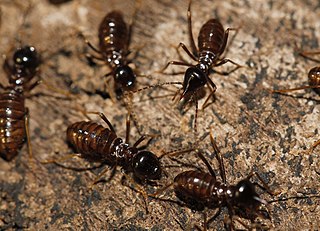Postelectrotermes militaris, the up-country tea termite, is a species of drywood termite of the genus Postelectrotermes. It is native to India and Sri Lanka. It is a serious pest of tea.
Neotermes kemneri, is a species of dry wood termite of the genus Neotermes. It is native to India and Sri Lanka.
Glyptotermes ceylonicus, is a species of damp wood termite of the genus Glyptotermes. It is endemic to high elevations Sri Lanka. It is a pest of dead and decaying wood of Hevea, Theobroma, Ficus, and Acacia species.
The Low-country tea termite,, also known as Low country live wood termite, is a species of damp wood termite of the genus Glyptotermes. It is endemic to high elevations Sri Lanka. It is a major pest of tea in low country area of Sri Lanka.

The West Indian drywood termite is a species of dry wood termite of the genus Cryptotermes. It is native to Java, Indonesia and exotic to Australia, Trinidad and Tobago and Sri Lanka. It is predominantly a house termite found in natural and man-made wooden structures. Thus, this is the most commonest and most devastating drywood pest termite found in the world. It is a larger termite species, with 4.55–7.15 millimetres length in soldiers.
Coptotermes gaurii, is a species of subterranean termite of the genus Coptotermes. It is native to South India and Sri Lanka. It is a serious pest of tea in Sri Lanka.
Heterotermes indicola, is a species of subterranean termite of the genus Heterotermes. It is native to tropical India, Pakistan and Sri Lanka but has extended its range into the subtropics and warm temperate areas of the Himalayan foothills to altitudes of about 2,000 m (6,600 ft). It causes damage to timber in buildings and is one of the most destructive termites in urban and agricultural areas in the world. Soldiers are about 4.1-4.9mm long. Extracts of garlic and Calotropis procera are known to have termiticidal effects on H. indicola.
Odontotermes escherichi, is a small species of termite of the genus Odontotermes. It is native to India, Sri Lanka and Peninsular Malaysia. It attacks many dead, tree stems and decaying logs.
The Fungus-growing termite,, also known as South Asian wood-destroying termite, is a small species of earth dwelling termite of the genus Odontotermes. It is native to India and Sri Lanka.
Odontotermes globicola is a species of small termite of the genus Odontotermes. It is native to India, Malaysia and Sri Lanka. It is found under flower pots and decaying logs. They construct small chambered nest with spherical combed termitaria.

Odontotermes horni, is a species of termite of the genus Odontotermes. It is native to India and Sri Lanka. It attacks many dead, decaying trees and fertilized soil. Though nests on ground, they do not construct a termitaria. It is a pest of tea, coconut and sugarcane.
Hypotermes obscuriceps, is a species of termite of the genus Hypotermes. It is native to India, Sri Lanka and Vietnam. It constructs a termitaria and is a pest of tea.
Microtermes obesi, the wheat termite, is a small species of termite of the genus Microtermes. It is native to India, Sri Lanka, Pakistan and Vietnam. It is a major pest of wheat and minor pest of sugarcane.
Speculitermes sinhalensis, is a species of termite of the genus Speculitermes. It is native to India and Sri Lanka. It was first found from Vavuniya. They are typical subterranean soil humus feeding termites, which can be found under logs, decaying trees, rocks.
Nasutitermes lacustris, is a species of termite of the genus Nasutitermes. It is found in India and Sri Lanka. This species builds nests on branches of forest trees and can be found in stems of trees like Anacardium, Hevea and Elaeocarpus.
Ceylonitermes escherichi is a species of termite. It is endemic to Sri Lanka.

Hospitalitermes monoceros, is a species of nasute termite of the genus Hospitalitermes. It was originally considered to be endemic to Sri Lanka, but was also found in India in 2013. It is an obligate lichen feeder. It is recorded from Cassia multijuga and Ficus religiosa trees and is a pest of tea.
Trinervitermes biformis, the snouted harvester termite, is a species of mound building termite in the genus Trinervitermes, native to India and Sri Lanka. The type species was described from the Bandarawela area of Sri Lanka. It is a pest of sugarcane and brinjal.
Dicuspiditermes nemorosus, is a species of small termite of the genus Dicuspiditermes. It is found in Sri Lanka, India, Malaysia and Borneo. The species is known to build three different types of mounding nests, where two termitaria have single protruding nest structure and third nest type is typified by several protruding nest all connected at the base.


